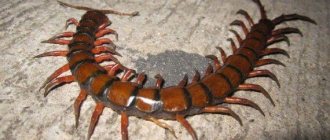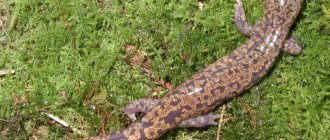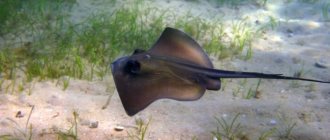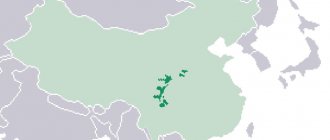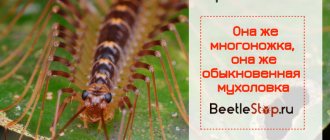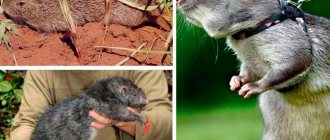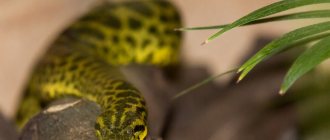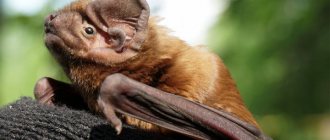- How many legs does a scolopendra have?
Whatever you say, the scolopendra is far from the most pleasant representative of the animal world, and it is also very dangerous for humans. Many species of scolopendra are poisonous and sometimes a scolopendra bite can even lead to fatal consequences; it is not for nothing that the giant scolopendra is included in the list of the most dangerous insects on the planet. Scolopendra belongs to the genus of millipedes, order Scolopendra. The name “scolopendra” is of ancient Greek origin and is translated into our language as “centipede”.
Description, structure, characteristics
Scolopendra is very reminiscent of a long and thick worm, black or brown with splashes of green. However, the color of some centipedes may differ depending on the species. The body length of the centipede is 10-15 cm, but sometimes it can reach 35 cm.
The body of the scolopendra consists of a head and a long torso, which in turn consists of twenty (and sometimes more) segments connected to each other by flexible
membranes protected by an exoskeleton. Each segment has its own pair of legs. The first pair of legs of the scolopendra are called the mandibles; they serve the scolopendra to grab potential prey and send it directly into its mouth.
The last pair of legs of the scolopendra is also different from the rest; it is large in size and serves as a kind of anchor for the insect, at the same time helping with movement through earthly burrows.
The head of the scolopendra is like a plate with eyes, two antennae and a pair of jaws. The scolopendra's compound eyes provide it with excellent vision and good orientation in space.
Lifestyle
How scolopendra attacks
Animals go hunting at night, preferring to wait out the heat of the day in a shelter. What does scolopendra eat? She is a predator, so her diet consists of only caught prey. Invertebrates and small animals cannot escape from the rapid rush and paralyzing poison. Young individuals feed on insects, while adults attack anyone who is not larger than the centipede itself. It could be a small snake, bird or lizard.
Attention. The venom of the giant tropical scolopendra is dangerous to humans. It causes numbness and temporary paralysis. The pain is equivalent to the sting of 20 bees.
The centipede eats its prey for several hours, biting off pieces from living but paralyzed prey. Her digestive system is primitive, so it takes a long time to get full. After the meal, the animal washes itself, passing the antennae and legs alternately through the jaws.
Reproduction
The breeding season occurs at the end of spring - beginning of summer. The male leaves a spermatophore - a sac with seed, and the female crawls through it, picking up the sperm. To lay eggs, the female digs a hole. This unpleasant animal is a caring mother. She protects the eggs and emerging babies by wrapping her legs around them. There are up to 100 centipedes in one clutch. The mother violently attacks anyone who approaches the shelter. It not only protects the eggs, but cleans them so they don't become moldy. Small centipedes are white in color and their bodies are soft.
The family does not stay together for long; the scolopendra soon crawls away. The offspring grows quickly, surviving several molts. Centipedes' bodies darken, but the colors will change until they reach maturity. Cases are common when larger individuals eat smaller ones.
How many legs does a scolopendra have?
The number of legs of a centipede directly depends on the number of segments of the body, and it is usually from 21 to 23, since each segment has its own pair of legs, then any decent centipede has 42-46 legs. It is also worth remembering that each of the scolopendra’s legs has a poisonous gland and, for example, if it comes into contact with human skin, it can cause inflammation.
Nutrition
As you probably already guessed, our today's heroine, centipede, is a notorious predator of the insect world; other smaller insects act as a source of food for centipedes: earthworms, beetles,
crickets, grasshoppers, etc.
Scolopendra caught a grasshopper.
But the giant scolopendra can easily attack small ones
lizards, frogs, birds, small snakes and even bats. To catch the latter, the centipede, holding the surface with its claws, climbs to the ceiling where it sleeps, then attacks the bat with its front claws, simultaneously wrapping itself around the victim and injecting poison into it.
Types: photos and names
There are about 600 species of these insects in nature, but we will describe the most interesting of them.
Giant scolopendra
As you probably already guessed from the name, this is the largest scolopendra, its body length reaches 35 cm. It is also the most dangerous, since its bite can be fatal to humans. The giant scolopendra lives in the tropics of South America.
Ringed scolopendra (Crimean scolopendra)
In our country it is better known as Crimean scolopendra, since its habitat is Southern Europe, including our Ukrainian Crimea. The Crimean scolopendra is not as large (and not as dangerous) as the giant one, its body length is on average 10 cm. The ringed scolopendra has a golden yellow color and is a very fast insect that eats other smaller insects.
California scolopendra
The Californian scolopendra lives in the arid regions of the Southern United States and Mexico. Its body length reaches 20 cm. It is distinguished by its bright orange color. Although its venom is not as toxic as that of the giant scolopendra, it can nevertheless easily cause inflammation of the skin in humans upon contact with the poisonous limbs of this centipede.
Scolopendra Lucas
Scolopendra Lucas also lives in Southern Europe. Its body is rusty in color and its head is heart-shaped.
House scolopendra (flycatcher)
The smallest and most harmless of centipedes, its body length is only 3 to 6 cm. Also, unlike its dangerous relatives, it has no poison and, as a result, does not pose any threat to humans. It lives in southern Europe, the Mediterranean and also in North Africa. It got its name because of its habit of settling in people’s houses, and although, as we have already noted, this scolopendra does not pose a threat, nevertheless, its presence in the house is not at all desirable. The domestic scolopendra feeds on small insects, usually flies, which is why it is even nicknamed the flycatcher.
Chinese scolopendra
This representative of the scolopendra kingdom lives in Asia, in particular China, and also in Australia. It is distinguished by its red color, which is why it is also known as the Chinese red centipede. Interesting fact: the inventive Chinese have learned to use the venom of the Chinese scolopendra for medical purposes; in the treatment of various skin diseases, it promotes the healing process in small doses.
Habitat
The Latin name of this arthropod is scolopendra gigantea . Belongs to the animal kingdom. But it is not an insect. This is an arthropod from the class of labiopods. It lives mainly in the tropics and subtropics. To be more precise:
- In South America;
- in Jamaica;
- to Puerto Rico;
- in Trinidad and other Caribbean islands.
In Europe, Asia and Africa, the giant scolopendra, fortunately, is not found. Is this arthropod found in the Seychelles, where more than 200 thousand tourists from all over the world vacation annually? No, but other species of scolopendra live there, which, by the way, can bite a person. So when going to this “paradise on earth”, you should be careful and avoid contact with such unpleasant centipedes.
Reproduction
Scolopendras become sexually mature by the second year of life. The act of copulation itself usually takes place in the silence of the night, so that no one can disturb the love idyll of a centipede couple. During sexual intercourse, the male produces a special cocoon, located in the last segment of his body; this cocoon contains seminal fluid - a spermatophore. During mating, the female draws this fluid into her genital opening, and a few months after mating she lays eggs/larvae. Moreover, up to 120 eggs are released per clutch, but not all survive. After a few more months, small ones emerge from the scolopendra larvae.
Prevention measures
If you take some preventative measures, insects such as centipedes will never appear in your house. All you need is:
- Get rid of everything that could be a comfortable breeding ground for these insects.
- If there is a toilet in the yard, it is better to regularly fill it with sawdust and ash.
- Bring the house into a normal sanitary condition so that insects that centipedes feed on cannot appear in it.
- Dry all rooms, getting rid of unwanted high humidity, which attracts not only centipedes.
- Make sure that there are no holes or cracks in the house through which insects can enter the house.
- Use boric acid powder to control insects by scattering it in problem areas.
- It is advisable to close the bathroom and sinks with special plugs at night.
- If the floors are wooden, then it is better to treat them with parquet mastic.
Despite its frightening appearance, with which the scolopendra scares household members, you should not be afraid of it, but on the contrary, you need to make sure that this insect remains alive. At the same time, you should think carefully about why she became interested in housing. It is quite possible that it is time to start fighting with other uninvited guests by starting a general cleaning of all premises.
Scolopendra bite!
Watch this video on YouTube
Danger to humans
Regarding the danger of scolopendra to humans, the giant scolopendra that lives in the jungles of South America is especially dangerous; its bite can actually cause severe poisoning, even death. As for the Crimean scolopendra living in our country, although it is not fatal, nevertheless, you should stay away from it.
Symptoms of a scolopendra bite (in particular our Crimean one):
hornet,
This discomfort lasts about two days.
Interesting fact: female scolopendras are more poisonous and dangerous than males.
Contents in home terrariums
Giant centipedes have become popular “pets” among exotic and invertebrate lovers in recent years. They are kept in a high terrarium of sufficient size with a lid on top so that the pet does not accidentally jump out of its home.
For a comfortable existence, it is important to maintain the necessary humidity, as well as the presence of a drinking bowl with settled water. Temperature: from 17-10 at night to 20-22ºС. Giant centipedes are fed quite rarely with large cockroaches, small frogs and lizards: according to experts, one mouse or 5-6 cockroaches is enough for them to survive for 1 month.
When keeping and caring for such huge pets, it is recommended to take care and take special measures to prevent them from escaping from the terrarium.
What to do if you are bitten
First of all, of course, it is best to simply prevent the scolopendra from biting you. She herself is unlikely to specifically attack a person, but she can bite in a state of fright and self-defense. Very often, scolopendras have a bad habit of crawling into tourists’ tents, so to avoid unwanted guests:
- use a closed tent with a zipper, and even such a tent should not be left open unattended.
- Inspect your tent thoroughly before going to bed.
- In the morning, check your clothes and things for the presence of scolopendras, they like to arrange a shelter for themselves in these items.
- Also remain vigilant when turning over stones or collecting dry branches, as centipedes may be hiding there.
If it does happen that scolopendra runs across a person’s skin, leaving a mark in the form of an inflamed stripe, measures should be taken immediately:
- wash the affected area with soap and water or disinfect with alcohol.
- then apply a sterile bandage.
- to drink a lot of water.
- provide peace to the victim.
- Do not drink alcohol under any circumstances (it speeds up the body’s metabolism, and with it the effect of scolopendra poison).
- It is highly advisable to consult a doctor for professional medical help.
If a scolopendra has bitten a pregnant woman, a child, an elderly person, a person suffering from cardiovascular diseases or prone to allergic reactions, then immediately going to the hospital for professional medical help is mandatory!
A meeting between a man and a giant centipede and what it threatens
The danger of this animal has been greatly exaggerated . All representatives of this species are poisonous because they have glands with neurotoxin. But scolopendra venom poses a mortal threat only to insects and small animals.
Human skin is too tough for them, so the possibility of death when meeting it is excluded, although contact with a centipede can cause inflammation of the skin and an allergic reaction. In the case of the largest representative of the species, everything is different. Given its size, it is capable of producing a rather painful bite, which causes swelling of a large area of the body and may be accompanied by burning and itching. The injury after such a bite takes a long time to heal, on average from 4 to 6 days. As mentioned earlier, the majority of these animals are practically harmless, but in any case there are exceptions!
The danger posed by a scolopendra bite depends on the species to which it belongs. When it bites through the skin, a dose of poison is released, which is accompanied by burning, swelling, weakness and dizziness. The only recorded death occurred in a small child, from the venom of Skolopendra subspinipes. This species has several names: orange scolopendra, Chinese and Vietnamese.
Some species of these predators, if disturbed, are capable of secreting a liquid that leaves burns on the skin. For example, the Californian scolopendra has this ability.
After being bitten by a predator, you must immediately wash the wound, apply something cold to it and immediately consult a doctor. Tetanus prophylaxis and a certain group of analgesics are often prescribed.
The most dangerous are female centipedes; their venom is more toxic and poses a danger to people with weak immune functions, those suffering from allergic diseases and children.
Video
And in conclusion, an interesting film about scolopendra.
Author: Pavel Chaika, editor-in-chief of Poznavaika magazine
When writing the article, I tried to make it as interesting, useful and high-quality as possible. I would be grateful for any feedback and constructive criticism in the form of comments on the article. You can also write your wish/question/suggestion to my email [email protected] or Facebook, with respect, the author.
Author page
